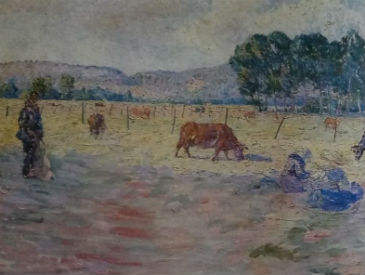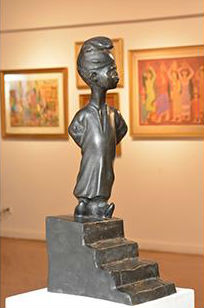Forty-eight works by 70 Egyptian masters of painting and sculpture are on display now at the Art Talks gallery in Zamalek, providing an overview of Egyptian art history and an opportunity for collectors to discover 20th century works.
The title of the exhibition, Mokhtar to Gazbia, sums up the history of contemporary Egyptian art, alluding to two of its leading figures, Mahmoud Mokhtar and Gazbia Sirri. The display makes a journey of an outstanding sculptor to that of a painter, who present themselves as the representatives of the Greats.
To Mahmoud Mokhtar, we owe the first modern Egyptian sculpture. His sculpture of 1911 represents the real son of the country, or Ibn El-Balad, dressed in his galabeya and sandals, as imagined by Mokhtar, at the beginning of the past century. Gazbia Sirri is often seen as the artist who continues to evolve throughout his career. He has crossed different currents and eras, sought refuge in abstraction, failing to marvel.
Ongoing until end of the year, the exhibition at Art Talks reviews the most important creations of the twentieth century in the visual arts. The 70 works on display tell the story of Egyptian art in this period, and the impressive panoply of artists places us at the heart of the concerns of these important figures.
The careful choice of works allows us to discover the unknown beginnings of many of them: works by Abdel-Hadi El-Gazzar, the immense Alexandrian talent (who died at the age of forty in 1966) or by Kamal Khalifa (who disappeared more than forty years ago) are displayed side-by-side with those by Mohamed Hassan and Ragheb Ayad, winners of the first Egyptian scholarship for arts students in Rome in 1926.
The works of Gazbia Sirri rub shoulders with those of Tahia Halim and Inji Aflatoun, thus completing the magic triangle of the committed pioneers of the Egyptian artistic movement.
Impressionism also has its place, represented by the work of Marguerite Nakhla and Mohamed Nagui.
Popular surrealism is expressed in its best form through the work of master Hamed Nada, while abstract calligraphy is also present, represented by Hamed Abdallah or in the paintings of Mounir Canaan, who mainly chose collage and pop art as his tool of expression.
We move from one current to another, from one era to another, all to the delight of collectors who can find everything they dream of.
Further on, we rediscover paintings by the Swiss artist Margo Veillon, who lived in Egypt for a long time and who did not escape the influences of the country, especially with regard to her choice of subjects.

Work by Mohamed Nagui (Photo: courtesy of Art Talks)
Exploring Egypt’s villages
Since the creation of the School of Fine Arts, thanks to the contribution of the family of Prince Youssef Kamel at the beginning of the last century, Egyptian artists have sought to distinguish themselves from their Western masters. They were always looking for other sources of inspiration and were trying to tap into more local subjects. Thus, they painted villagers, either through portraits or paintings which captured scenes of bucolic life.
The landscapes of beautiful Egypt are recurrent in the exhibition, as they were very popular among the pioneers of the time. Even when it comes to abstraction, traces of an Egyptian identity are easily detectable. Egyptian artists belonging to different movements or currents drew on the country's long history to distinguish themselves, even while imbibing modernism. Many have had huge success abroad, such as Mohamed Sabri in Spain, IInji Aflatoun in France, and Georges Sabbagh, whose works can be found in museums around the world.
The contribution of the 48 names on display is really signficant. These are the artists who have trained all generations to come, through the diversity of their styles, techniques and subjects. Although the exhibition cannot trace the evolution of each artist and follow the various phases of their career, but it provides an overview of the eras, in order to give a general and fairly complete idea of the art of precursors, while still following a certain chronology.
The Al-Fan Wal Horriya (“Art and Freedom”) movement of the years 1930-1940 is represented by one of its founders, namely Fouad Kamel, who together with Georges Henein was at the heart of the movement that advocated art, surrealism and freedom.
The exhibition also shows the contribution of the written press, over time, as an effective support for these artists. They were welcomed by the newspapers to express their thoughts. Thus, we find Salah Taher's work titled Peace, making the cover of the magazine Octobar (October), at the date of its creation in 1978. On the other hand, Hussein Bicar, the talented painter renowned for his portraits and his critics, was one pillars of Akhbar Al-Youm newspaper for many years.
The exhibition highlights all these details, provoking reflection on the work of these masters who won their bet, even if it was risky.

Ibn El-Balad by Mahmoud Mokhtar (Photo: courtesy of Art Talks)
Highlights of other works on display
In the Naked Woman On the Sofa (1943) by the painter and sculptor Saad Al-Khadem (1913-1987), the artist has succeeded in a composition that excludes vulgarity. Nothing is too much in this painting, of a woman lying on a carpet, resting her back against a sofa. The earth tones give a feeling of intimacy.
We notice the influence of orientalist painters who have already dealt with the subject. Because this work by Al-Khadem can, in fact, recall La Sieste by Marius de Buzon, who drew women napping in Algiers in 1933. It also reminds us to some extent of L'Abondance de Léon Cauvy, who dates back to 1920, with a beautiful woman lying on a sofa. The mystery of the concerned look of the female model is part of its charm. Is it just the effect of heat? A personal problem? She alone knows the secret.
Popular surrealism comes in the form of watercolour brushstrokes by Hamed Nada in his untitled canvas from 1987. The painter captures a moment when two musicians are in a trance. Synchronising their movements, they tap on their percussion instruments and follow the rhythm by tapping their feet on the ground. Swans dance and the lamp on the ceiling lights up the picture.
The popular motifs specific to Hamed Nada (1924-1990) are still there, as he grew up in the Fatimid Old Cairo and was influenced by the atmosphere of its alleys, yet still following the artistic trends of his time. The master of "Egyptian popular surrealism," Nada has marked several other artists, including Mohamed Nagui and Abdel-Hadi El-Gazzar.
After studying fine arts in Egypt, Nada studied mural art at the Royal Academy of Fine Arts in San Fernando in Madrid. He was never afraid to deal with the anxieties of the common people in his paintings, which abound in symbolic motifs.
And moving to Inji Aflatoun (1924-1989) we find a committed artist who came from an aristocratic background yet who has never refrained from campaigning for social rights, for equality and for freedoms. This engagement even cost her four years of imprisonment, between 1959 and 1963.
Aflatoun was a Marxist seeking the evolution and the progress of the society. When she was a teenager, she had had a very difficult time at her religious school, which already embodied a state of imprisonment in her head.

Work by Inji Aflatoun (Photo: courtesy of Art Talks)
The exhibition continues until 31 December at Art Talks Egypt, 8 Al-Kamel Mohamed Street, Zamalek, Cairo.
This article was originally published in French in Al Ahram Hebdo's 18 December 2019 issue.
For more arts and culture news and updates, follow Ahram Online Arts and Culture on Twitter at @AhramOnlineArts and on Facebook at Ahram Online: Arts & Culture
Short link: